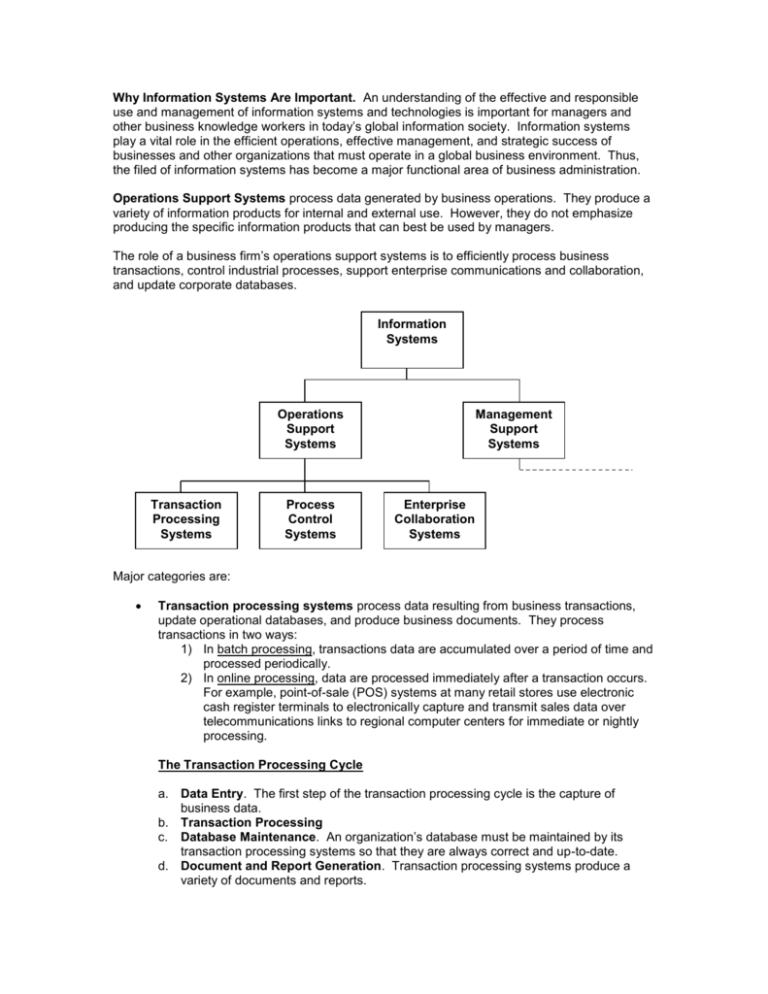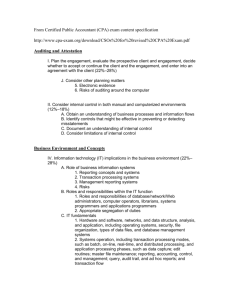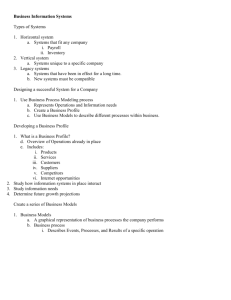Operations Support Systems process data generated by business
advertisement

Why Information Systems Are Important. An understanding of the effective and responsible use and management of information systems and technologies is important for managers and other business knowledge workers in today’s global information society. Information systems play a vital role in the efficient operations, effective management, and strategic success of businesses and other organizations that must operate in a global business environment. Thus, the filed of information systems has become a major functional area of business administration. Operations Support Systems process data generated by business operations. They produce a variety of information products for internal and external use. However, they do not emphasize producing the specific information products that can best be used by managers. The role of a business firm’s operations support systems is to efficiently process business transactions, control industrial processes, support enterprise communications and collaboration, and update corporate databases. Information Systems Operations Support Systems Transaction Processing Systems Process Control Systems Management Support Systems Enterprise Collaboration Systems Major categories are: Transaction processing systems process data resulting from business transactions, update operational databases, and produce business documents. They process transactions in two ways: 1) In batch processing, transactions data are accumulated over a period of time and processed periodically. 2) In online processing, data are processed immediately after a transaction occurs. For example, point-of-sale (POS) systems at many retail stores use electronic cash register terminals to electronically capture and transmit sales data over telecommunications links to regional computer centers for immediate or nightly processing. The Transaction Processing Cycle a. Data Entry. The first step of the transaction processing cycle is the capture of business data. b. Transaction Processing c. Database Maintenance. An organization’s database must be maintained by its transaction processing systems so that they are always correct and up-to-date. d. Document and Report Generation. Transaction processing systems produce a variety of documents and reports. e. Inquiry Processing. Many transaction processing systems allow you to use the Internet, intranets, extranets, and web browsers or database management query languages to make inquiries and receive responses concerning the results of transaction processing activity. Process control systems monitor and control industrial processes. For example, a petroleum refinery uses electronic sensors linked to computers to continually monitor chemical processes and make instant adjustments that control the refinery process. Enterprise collaboration systems support team, workgroup, and enterprise communications and collaboration. For example, knowledge workers in a project team may use electronic mail to send and receive electronic messages, and videoconferencing to hold electronic meetings to coordinate their activities. The goal of enterprise collaboration systems is to enable us to work together more easily and effectively by helping us to: a) Communicate: Sharing information with each other. b) Coordinate: Coordinating our individual work efforts and use of resources with each other. c) Collaborate: Working together cooperatively on joint projects and assignments. Teams and workgroups can be as formal and structured as a traditional business office or department. Or they can be less formal and structured like the members of process teams in a manufacturing environment. Or they can be as informal, unstructured, and temporary as an ad hoc task force or a project team whose members work for different organizations in different parts of the world. An enterprise collaboration system is an information system. Therefore, it uses hardware, software, data, and network resources to support communication, coordination, and collaboration among the members of business teams and workgroups. References: Introduction to Information Systems, Essentials for the Internetworked Enterprise, 9th Edition, James A. O’Brien, The McGraw-Hill Companies, Copyright 2000,1997,1994,1991,1988,1982 http://cwx.prenhall.com/bookbind/pubbooks/mcleod2/chapter1/custom4/deluxe-content.html










